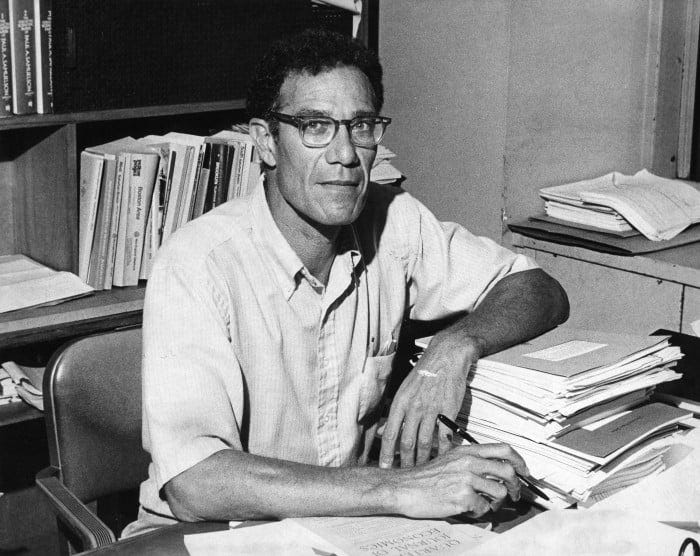The celebrated economist Robert Solow has died at the age of 99. I met him just once a few years ago when he visited our department to deliver a public lecture. His granddaughter Anna Solow-Collins—now an economist at the Department of Transportation—was one of our undergraduate students at the time.
Solow is best known for his model of growth which is simple in the best sense, making its point without needless complication. Under the assumptions of the model, an increase in saving can only increase an economy’s per-capita growth rate temporarily, hastening its approach to a steady state ratio of capital to labor. The implication is that persistent growth requires ongoing technological progress. The model does not explore the determinants of innovation, so as Solow himself acknowledged, there is “some truth” to the criticism that his theory “leaves the main factor in economic growth unexplained.”
With over 42,000 citations, Solow’s paper on growth is among the most influential in economics. Much of the subsequent literature has built on his foundations, and in a survey article published in 1994, he took stock of some of these developments.
Solow had treated the savings rate as an exogenous parameter, which soon came to be seen as methodologically unacceptable. In order to derive savings as an outcome of an explicit optimization problem, his model was augmented to include a representative agent making intertemporal choices over an infinite horizon, along lines initially proposed by Frank Ramsey. Solow did not consider this embellishment appealing:
Maybe I reveal myself merely as old-fashioned, but I see no redeeming social value in using this construction, which Ramsey intended as a representation of the decision-making of an idealized policymaker, as if it were a descriptive model of an industrial capitalist economy. It adds little or nothing to the story anyway, while encumbering it with unnecessary implausibilities and complexities.
More substantively, Solow took issue with some of the assumptions in an emerging endogenous growth literature, which assumed constant returns to capital to escape the conclusion that the savings rate did not influence growth in the long run. His concern here was with the robustness of these models to slight changes in specification:
Lucas emphasized in his 1988 article that a touch of diminishing returns to capital (human capital in his case) would change the character of the model drastically, making it incapable of generating permanent growth. He did not notice that a touch of increasing returns to capital would do the same, but in a quite different way… the stock of capital becomes infinite in finite time. (It is one thing to say that a quantity will eventually exceed any bound. It is quite another to say that it will exceed any stated bound before Christmas.) It takes a little calculus to show that “fairly explosive” puts it mildly.
This is an important concern, referred to as structural instability in the dynamical systems literature. The criticism does not apply to models of endogenous technological progress, which Solow considered promising. He was especially enamored of the approach taken by Paul Romer.
While Solow’s influence on the profession through his writings was profound, his influence through the students he advised was even greater. Take a look at his academic family tree, and you will see an extraordinary collection of economists. Under his direct supervision were Anthony Atkinson, Peter Diamond, George Akerlof, Robert Hall, Martin Weitzman, William Nordhaus, Avinash Dixit, Alan Blinder, Glenn Loury, Olivier Blanchard, Michael Woodford, and many others.
Some of his former students were themselves incredibly fertile (in generating economists), so Solow has an extraordinary collection of academic grandchildren. Through Akerlof we reach Rachel Kranton, through Diamond we reach Andrei Shleifer and Michael Rothschild, through Hall we reach Valerie Ramey, through Nordhaus we reach Paul Krugman, through Dixit we reach Dani Rodrick, and on and on. Through Blanchard alone we reach Greg Mankiw, Nobuhiro Kiyotaki, Roland Bénabou, Ricardo Caballero, David Laibson, Alessandra Casella, and Robert Shimer (among others). We even have a prize-winning great-grandchild: Oliver Hart, via Rothschild. From Hart we reach Steven Tadelis, and from Tadelis we reach Navin Kartik and Marina Halac—Solow’s academic great-great-great-grandchildren.
The person on this list of descendants whom I know best is Glenn Loury, who acknowledged his debt to Solow in the preface to his DuBois lectures, published as The Anatomy of Racial Inequality. Glenn notes that much of the book draws on the first chapter of his dissertation. This remains his most widely cited paper, despite being published in a collected volume, more influential even than his many papers in top journals. It is being taught in advanced courses to this day; see James Heckman’s slides here.
Scholars have influence through their work, which can be tracked and traced through a thicket of citations. But they also have influence through their interpersonal guidance, which remains largely invisible and unheralded. Solow’s influence through both channels was staggering and profound. I cannot think of any equal.





He could be critical of Romer (there was a representative agent in some versions of the model), but, yes, there was respect.
Thank you for your fascinating tribute to Solow. The family tree is very interesting. Did he not have a single female student? Curious.